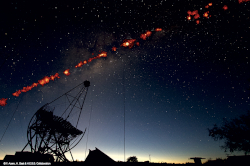https://en.wikipedia.org/wiki/Gamma-ray_astronomy wrote:
<<Gamma-ray astronomy is the astronomical observation of gamma rays, the most energetic form of electromagnetic radiation, with photon energies above 100 keV. (Radiation below 100 keV is classified as X-rays and is the subject of X-ray astronomy.) Observation of gamma rays first became possible in the 1960s. Their observation is much more problematic than that of X-rays or of visible light, because gamma-rays are comparatively rare, even a "bright" source needing an observation time of several minutes before it is even detected, and because gamma rays are difficult to focus, resulting in a very low resolution.
The most recent generation of gamma-ray telescopes (2000s) have a resolution of the order of 6 arc minutes in the GeV range (seeing the Crab Nebula as a single "pixel"), and about 1.5 arc minutes in the high energy X-ray (100 keV) range seen by High-Energy Focusing Telescope (2005). [The Chandra X-ray Observatory (1999) has a resolution of 0.5 arc seconds in the low energy X-ray (1 keV).]
The mechanisms emitting gamma rays are diverse, mostly identical with those emitting X-rays but at higher energies, including electron–positron annihilation, the inverse Compton effect, and in some cases also the decay of radioactive material in space reflecting extreme events such as supernovae and hypernovae, and the behaviour of matter under extreme conditions, as in pulsars and blazars. In a 18 May 2021 press release, China's Large High Altitude Air Shower Observatory (LHAASO) reported the detection of a dozen ultra-high-energy gamma rays with energies exceeding 1 peta-electron-volt, including one at 1.4 PeV [1,400 TeV], the highest energy photon ever observed. The authors of the report have named the sources of these PeV gamma rays PeVatrons. Gamma-ray astronomy observations are still limited by non-gamma-ray backgrounds at lower energies, and, at higher energy, by the number of photons that can be detected. Larger area detectors and better background suppression are essential for progress in the field.
Very energetic gamma rays, with photon energies over ~30 GeV, can also be detected by ground-based experiments. The extremely low photon fluxes at such high energies require detector effective areas that are impractically large for current space-based instruments. Such high-energy photons produce extensive showers of secondary particles in the atmosphere that can be observed on the ground, both directly by radiation counters and optically via the Cherenkov light which the ultra-relativistic shower particles emit. Gamma radiation in the TeV range emanating from the Crab Nebula was first detected in 1989 by the Fred Lawrence Whipple Observatory at Mt. Hopkins, in Arizona in the USA. Modern Cherenkov telescope experiments like H.E.S.S., VERITAS, MAGIC, and CANGAROO III can detect the Crab Nebula in a few minutes. The most energetic photons (up to 16 TeV) observed from an extragalactic object originate from the blazar, Markarian 501 (Mrk 501). Markarian 501 (or Mrk 501) is a blazar or BL Lac object, which is an active galactic nucleus with a jet that is shooting towards the Earth. The gamma rays from Mrk 501 are extremely variable, undergoing violent outbursts. (The galaxy is also variable in visible light between magnitude 14.5 and 13.6.) The gamma ray spectrum of Mrk 501 shows two humps. One is below 1 keV and can be considered to be X rays and the other is above 1 TeV. During flares and outbursts the peaks increase in power and frequency. Flares lasting 20 minutes with rise times of 1 minute have been measured by MAGIC. In these flares the higher energy gamma rays (of 1.2 Tev) were delayed 4 minutes over the 0.25 TeV gamma rays.>>
 HEAPOW: Over African Skies (2021 Oct 04)
HEAPOW: Over African Skies (2021 Oct 04)
